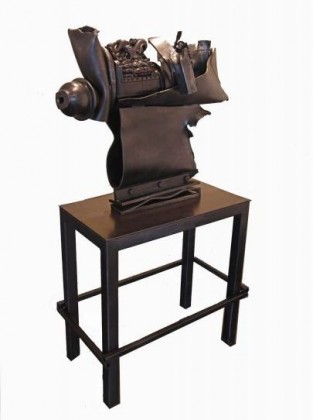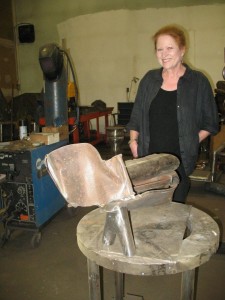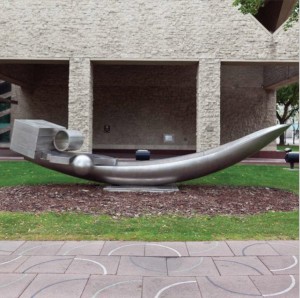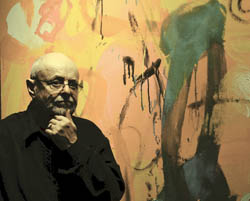ART: Abstract metal sculpture shines in Isla Burns exhibit
Posted on September 18, 2012 By Stuart Adams Front Slider, Visual Arts
 “Organic” is an odd word to describe abstract metal sculpture, but the term was overheard several times at the opening of “Samskara” by Isla Burns, at the Peter Robertson Gallery until October 2. There was another popular description among first night viewers – “tactile.” The sculptures almost invite you to touch them, the smaller ones somehow asking to be picked up, even cradled.
“Organic” is an odd word to describe abstract metal sculpture, but the term was overheard several times at the opening of “Samskara” by Isla Burns, at the Peter Robertson Gallery until October 2. There was another popular description among first night viewers – “tactile.” The sculptures almost invite you to touch them, the smaller ones somehow asking to be picked up, even cradled.
The collection of 17 pieces is intriguing and richly pleasing. Dark metal shapes fold, layer and curve in and about themselves in seemingly random patterns, but which also suggest recognizable elements, which the artist describes as “the imagery of the vessel, still life, altars, landscapes and columns.”
 Burns’s attention to detail is well-known. She’s earned a reputation for combining meticulous craftsmanship with creativity. Part of her expressiveness is enabled by working with lighter steel that has a lower melting point than other metals.
Burns’s attention to detail is well-known. She’s earned a reputation for combining meticulous craftsmanship with creativity. Part of her expressiveness is enabled by working with lighter steel that has a lower melting point than other metals.
“I heat it until it gets to what the blacksmiths call ‘cherry red’,” she explains, so the metal becomes soft and pliable, easily folded.
If you live in Edmonton, you should be familiar with Burns’ work whether you know it or not. Drive by the north side of City Hall and you can’t miss the monumental “Caravel” (below) – a four tonne, canoe-like vessel containing a cube and a sphere and other abstract elements. That piece from the early ‘90s is a noteworthy forerunner of today’s work. It contains aspects of the formal approach in which the artist was trained – Burns received her Master of Visual Arts in sculpture at the U of A in the late ‘70s – which espouses an unemotional approach to combining volume, texture, colour and shape. But “Caravel” also contains references to Burns’s long, creative journey leading to today’s work, which she describes as being “less formal and more expressive.”
 The title of the exhibition provides further insight into the work. “Samskara” comes from a Sanskrit word that means “deep memories or impressions that come from the subconscious or from past lives,” Burns says. “Samskara marks us unforgettably in a profound way and is permanently stamped into our psyche.”
The title of the exhibition provides further insight into the work. “Samskara” comes from a Sanskrit word that means “deep memories or impressions that come from the subconscious or from past lives,” Burns says. “Samskara marks us unforgettably in a profound way and is permanently stamped into our psyche.”
Her modern sculptures also recall the highly decorative and illustrative work she grew up with in India, where she was born and lived before moving to Scotland in her mid-teens. While she utilizes found objects of cast iron and steel, a piece called “Sea Warrior” (top picture) incorporates one of her last patterned fragments of antique Indian wood architectural details obtained from temples and buildings. Purchased some 35 years ago – right around the time she started her art career – Burns cleaned and stripped off layers of paint, before re-painting it to resemble the metallic elements.
 This show is not to be missed. An additional attraction is the paintings of her husband, Phil Darrah (right). Rather than show bare walls, the gallery decided to exhibit his recent works, and they create another welcome facet in the space.
This show is not to be missed. An additional attraction is the paintings of her husband, Phil Darrah (right). Rather than show bare walls, the gallery decided to exhibit his recent works, and they create another welcome facet in the space.













